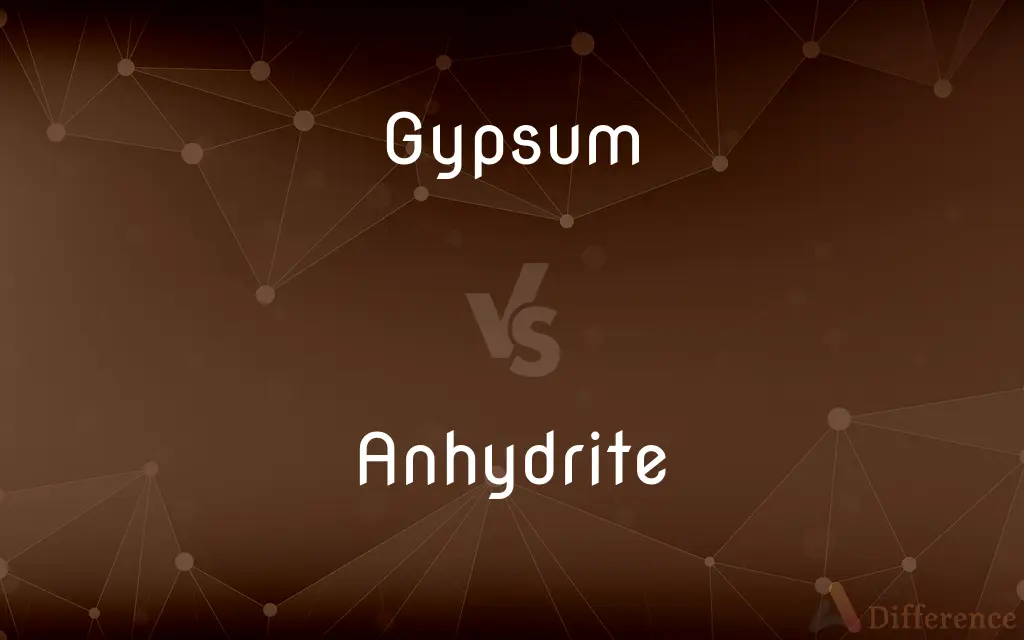Gypsum vs. Anhydrite — What's the Difference?
By Tayyaba Rehman — Updated on October 27, 2023
Gypsum is a hydrated calcium sulfate mineral used in construction and agriculture, while anhydrite is its dehydrated form, harder and used in cement.

Difference Between Gypsum and Anhydrite
Table of Contents
ADVERTISEMENT
Key Differences
Gypsum is a soft mineral composed of calcium sulfate dihydrate. Anhydrite is also a calcium sulfate mineral, but it lacks water molecules.
Gypsum has a variety of uses, from construction (drywall) to agriculture (soil conditioning). Anhydrite is less common and often used in cement.
The presence of water in gypsum makes it less dense and softer than anhydrite. Anhydrite is denser and harder due to the absence of water.
Gypsum can be transformed into anhydrite by heating. Conversely, anhydrite can absorb water and convert back to gypsum.
In nature, gypsum often forms through the evaporation of seawater. Anhydrite typically forms under higher temperatures and pressures.
ADVERTISEMENT
Comparison Chart
Chemical Composition
Calcium sulfate dihydrate
Calcium sulfate (without water)
Density and Hardness
Less dense, softer
Denser, harder
Uses
Construction, agriculture
Cement, industry
Formation
Evaporation at lower temperatures
Higher temperatures and pressures
Transformation
Can become anhydrite by heating
Can revert to gypsum with water
Compare with Definitions
Gypsum
Hydrated Sulfate
Gypsum contains water molecules in its structure.
Anhydrite
Mineral
Anhydrite is a mineral found in evaporite deposits.
Gypsum
Mineral
Gypsum is commonly found in sedimentary rocks.
Anhydrite
Formation
Anhydrite forms under high temperatures.
Gypsum
Industrial Use
Gypsum is used in making plaster and cement.
Anhydrite
Dehydrated Form
Anhydrite lacks water in its structure.
Gypsum
Construction Material
They used gypsum to make drywall.
Anhydrite
Hardness
Due to its hardness, anhydrite is used in various industrial applications.
Gypsum
Agriculture
Farmers apply gypsum to improve soil quality.
Anhydrite
Cement Ingredient
They used anhydrite as an additive in cement.
Gypsum
Gypsum is a soft sulfate mineral composed of calcium sulfate dihydrate, with the chemical formula CaSO4·2H2O. It is widely mined and is used as a fertilizer and as the main constituent in many forms of plaster, blackboard/sidewalk chalk, and drywall. A massive fine-grained white or lightly tinted variety of gypsum, called alabaster, has been used for sculpture by many cultures including Ancient Egypt, Mesopotamia, Ancient Rome, the Byzantine Empire, and the Nottingham alabasters of Medieval England.
Anhydrite
Anhydrite, or anhydrous calcium sulfate, is a mineral with the chemical formula CaSO4. It is in the orthorhombic crystal system, with three directions of perfect cleavage parallel to the three planes of symmetry.
Gypsum
A widespread colorless, white, or yellowish mineral, CaSO4·2H2O, used in the manufacture of plaster of Paris, various plaster products, and fertilizers.
Anhydrite
A colorless, white, gray, blue, or lilac mineral of anhydrous calcium sulfate, CaSO4, occurring as layers in gypsum deposits.
Gypsum
A mineral consisting of hydrated calcium sulphate. When calcinated, it forms plaster of Paris.
Anhydrite
(mineral) An evaporite mineral made of anhydrous calcium sulfate.
Gypsum
A mineral consisting of the hydrous sulphate of lime (calcium). When calcined, it forms plaster of Paris. Selenite is a transparent, crystalline variety; alabaster, a fine, white, massive variety.
Anhydrite
A mineral of a white or a slightly bluish color, usually massive. It is anhydrous sulphate of lime, and differs from gypsum in not containing water (whence the name).
Gypsum
A common white or colorless mineral (hydrated calcium sulphate) used to make cements and plasters (especially plaster of Paris)
Common Curiosities
Is anhydrite naturally occurring?
Yes, it forms under specific geological conditions.
What is gypsum?
Gypsum is a soft mineral used in construction and agriculture.
How are gypsum and anhydrite related?
Anhydrite is essentially dehydrated gypsum.
What are the uses of anhydrite?
Anhydrite is used in cement and various industrial applications.
Can gypsum transform into anhydrite?
Yes, by heating and removing its water content.
Where is gypsum commonly found?
Gypsum is often found in sedimentary rock formations.
Is anhydrite used in agriculture?
It's less common in agriculture compared to gypsum.
Can anhydrite revert to gypsum?
Yes, when it absorbs water.
Is anhydrite soluble in water?
It's minimally soluble, less so than gypsum.
What is anhydrite?
Anhydrite is a denser, waterless form of calcium sulfate.
Why is gypsum preferred in construction?
Its softness and ease of use make it ideal for drywall.
What is the hardness of gypsum?
It's quite soft, around 2 on the Mohs hardness scale.
Are gypsum and anhydrite visually different?
Yes, they often have different colors and crystal structures.
How is gypsum used in agriculture?
It's used to improve soil structure and nutrient content.
Is gypsum used in cement?
It's sometimes used but less commonly than anhydrite.
Share Your Discovery

Previous Comparison
On vs. At
Next Comparison
Wife vs. GirlfriendAuthor Spotlight
Written by
Tayyaba RehmanTayyaba Rehman is a distinguished writer, currently serving as a primary contributor to askdifference.com. As a researcher in semantics and etymology, Tayyaba's passion for the complexity of languages and their distinctions has found a perfect home on the platform. Tayyaba delves into the intricacies of language, distinguishing between commonly confused words and phrases, thereby providing clarity for readers worldwide.
















































